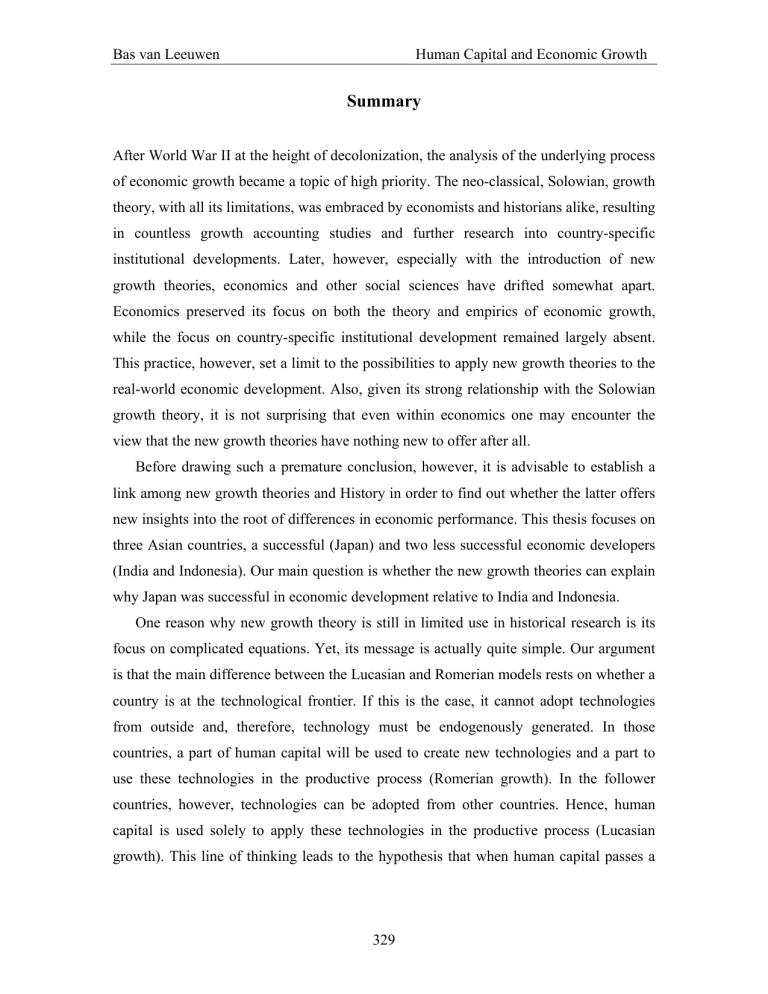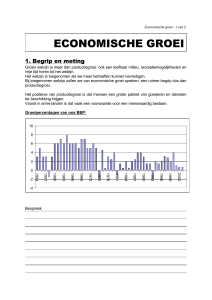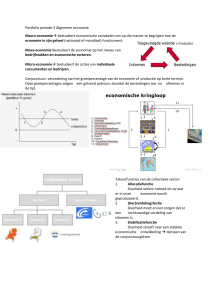
Bas van Leeuwen
Human Capital and Economic Growth
Summary
After World War II at the height of decolonization, the analysis of the underlying process
of economic growth became a topic of high priority. The neo-classical, Solowian, growth
theory, with all its limitations, was embraced by economists and historians alike, resulting
in countless growth accounting studies and further research into country-specific
institutional developments. Later, however, especially with the introduction of new
growth theories, economics and other social sciences have drifted somewhat apart.
Economics preserved its focus on both the theory and empirics of economic growth,
while the focus on country-specific institutional development remained largely absent.
This practice, however, set a limit to the possibilities to apply new growth theories to the
real-world economic development. Also, given its strong relationship with the Solowian
growth theory, it is not surprising that even within economics one may encounter the
view that the new growth theories have nothing new to offer after all.
Before drawing such a premature conclusion, however, it is advisable to establish a
link among new growth theories and History in order to find out whether the latter offers
new insights into the root of differences in economic performance. This thesis focuses on
three Asian countries, a successful (Japan) and two less successful economic developers
(India and Indonesia). Our main question is whether the new growth theories can explain
why Japan was successful in economic development relative to India and Indonesia.
One reason why new growth theory is still in limited use in historical research is its
focus on complicated equations. Yet, its message is actually quite simple. Our argument
is that the main difference between the Lucasian and Romerian models rests on whether a
country is at the technological frontier. If this is the case, it cannot adopt technologies
from outside and, therefore, technology must be endogenously generated. In those
countries, a part of human capital will be used to create new technologies and a part to
use these technologies in the productive process (Romerian growth). In the follower
countries, however, technologies can be adopted from other countries. Hence, human
capital is used solely to apply these technologies in the productive process (Lucasian
growth). This line of thinking leads to the hypothesis that when human capital passes a
329
Summary
certain threshold level (a country arrives at the technological frontier), a switch is made to
Romerian growth. In both models, however, human capital is the crucial variable.
As mentioned above, many economic studies so far have mostly focussed on the
development of the theory itself and the empirical testing. However, this came at the cost
of understanding country-specific aspects. In addition, often even the choice of human
capital variable used in these analyses is not explained. Our focus is thus mainly on the
latter two issues although we will address the first two as well as far as they show how
the choice of human capital variable and the institutional analysis may change the use of
growth theory and its application in empirical analysis.
The first question when analysing the explanatory power of the new growth theories
is what human capital actually is. In chapter 2 we discussed some of the more common
human capital variables. However, the most often used human capital proxy ‘average
years of schooling in the population’ only captures the quantity of human capital. Hence,
each extra year of schooling is valued as if it had the same effect. Still, bearing in mind
that an increase from say 10 to 11 years of schooling is more costly than from 2 to 3 years,
it is likely that one will find decreasing marginal returns to human capital accumulation.
If one allows an increase in the quality of human capital over time in the model, however,
the often debated constant marginal return assumption of Lucas becomes more realistic.
‘Average years of education’ may also be an unfortunate choice as a human capital proxy
since it enters into the second, human capital producing, sector of the Lucas model as an
input. As a result, by inserting the level and the change of ‘average years of schooling’ in
a growth regression, one can test the Lucasian theory of growth, but not the model of
Romer. Therefore, it is preferable to use alternative human capital measures including
both the quantitative and qualitative aspects of human capital.
The second question that is important for analyzing the relationship between human
capital and economic growth relates to institutions. In chapter 4 we conclude that the
differences among India, Indonesia, and Japan in human capital formation can be traced
back to the construction of their education systems. In Japan, as in most Western
countries, the education system arose in the late eighteenth and early nineteenth century
from the need for economic development and was responsive to the special
characteristics of the respective societies. In India and Indonesia, on the other hand,
330
Bas van Leeuwen
Human Capital and Economic Growth
similarly to most developing economies, it were largely ideas of ‘creating an indigenous
class of literati’, a ‘moral duty of the colonizer country’, nationalism, and, after World
War II, the ‘idea of progress by education’, ‘lack of finances’, and ‘policies of
international organisations’ that drove educational development. In other words, the
education systems of India and Indonesia were influenced by global, or at least external,
factors.
These institutional developments resulted in two major differences between, on
the one hand, India and Indonesia, and, on the other hand, Japan. First, in all three
countries the level of education steadily increased over time. Since most of the literature
suggests the human capital coefficients in growth regressions to differ by the levels of
education, this means that the pattern of the human capital coefficients over time is the
same in all three countries. Second, because the Japanese education system developed
naturally from an internal, societal, demand, the process of increasing formal education
started earlier and was more efficient. This means that 1) the breakpoints in the human
capital coefficient in Japan precede those in India and Indonesia, and 2) because of the
higher efficiency, the human capital coefficient of Japan was higher than that of India and
Indonesia.
The third question, which is often the subject of debate in the economic literature,
concerns the application of the theories of economic growth. Before trying to estimate a
final model, it is crucial to determine which model is applicable. Given our newly
estimated human capital variable, we find Lucasian growth in India and Indonesia while
in Japan it is only present in the first half of the twentieth century. As we just argued that
Romerian growth is characteristic of technological frontier countries, it is not surprising
that we found Romerian growth in Japan in the second half of the twentieth century.
Only in fourth instance we arrive at the actual regressions in chapter 7. These
regressions now offer us the possibility not only to find but also to identify the
breakpoints in the human capital coefficients as corresponding to the institutional
development in formal education. In addition, they show that economic growth is largely
Lucasian (except for Japan in the second half of the twentieth century). Also we find that
an imbalance effect seems present during Lucasian growth. These results do not change if
331
Summary
we correct for inclusion of physical capital. It also shows that, under rather strict
circumstances, physical capital can be left out of the regression.
Discussing these four questions shows that new growth theory cannot be disregarded
that easily for analysing economic divergence. However, to explain why Japan was a
successful developer while India and Indonesia were not, it is important to add two extra
elements. First, one needs to use a series that reflects all aspects of human capital that are
also crucial in these theories. If one wants to test whether there are constant marginal
returns to human capital accumulation, excluding the quality of human capital (which
might be an important source of constant marginal returns) will bias your findings.
Second, it is crucial to keep account of the institutional developments both between
countries and over time. They are not only necessary for a sound economic interpretation
of any regression results, but also may hint which variables to include in a regression
between human capital and growth. Applying these four steps to the countries in our
study shows that human capital can explain from around 80% of the economic divergence
in the first half of the century to around 30% in the second half.
Samenvatting
Het hoogtepunt van de dekolonisatiegolf na de Tweede Wereldoorlog leidde ertoe dat de
analyse van de onderliggende processen van economische groei hoog op de agenda kwam
te staan. Dit resulteerde in een neoklassieke, Soloviaanse, groeitheorie die, met al zijn
beperkingen, door zowel economen als historici werd omarmd. Dit leidde zowel tot een
groot aantal growth accounting studies als tot studies naar landenspecifieke institutionele
ontwikkelingen. Echter, vooral sinds de introductie van de nieuwe groeitheorie in de
jaren ’80, zijn de economie en de overige sociale wetenschappen enigszins uit elkaar
gegroeid. Dit leidde binnen de economische discipline tot een focus op theorie en empirie
terwijl de landenspecifieke institutionele ontwikkeling vrijwel geheel afwezig was. Dit
beperkte de mogelijkheden om de, hoofdzakelijk theoretische, nieuwe groeitheorieën toe
te passen op praktische economische ontwikkeling. Mede vanwege hun sterke relatie met
de neoklassieke groeitheorie is het niet verrassend dat zelfs binnen de economische
332
Bas van Leeuwen
Human Capital and Economic Growth
discipline soms het argument naar voren wordt gebracht dat de nieuwe groeitheorieën
niets nieuws te bieden hebben.
Voordat een dergelijke conclusie getrokken kan worden is het belangrijk om de
nieuwe groeitheorie beter te laten aansluiten bij de geschiedschrijving om op deze manier
te analyseren of de historische discipline nieuwe inzichten kan bieden in de wortels van
economische divergentie. Dit proefschrift richt zich op drie Aziatische landen waarvan
één land (Japan) een succesvolle en twee (India en Indonesië) een minder succesvolle
economische ontwikkeling doormaakten. Onze hoofdvraag is of de nieuwe groeitheorieën
kunnen verklaren waarom Japan een relatief succesvolle economische ontwikkeling
kende in vergelijking met India en Indonesië.
Een mogelijke reden waarom de nieuwe groeitheorieën nog steeds weinig in
historisch onderzoek worden toegepast is hun focus op gecompliceerde mathematische
vergelijkingen. Hun eigenlijke boodschap is echter vrij eenvoudig. Het belangrijkste
verschil tussen de twee groepen binnen de nieuwe groeitheorieën berust op de vraag of
een land voorop loopt in technologische ontwikkeling. In een dergelijk geval kan een
land geen technologieën overnemen van andere landen. Daarom moet verdere
technologische ontwikkeling endogeen gegenereerd worden. In dergelijke landen zal een
gedeelte van het menselijk kapitaal ingezet worden om nieuwe technologieën te creëren
en een gedeelte om deze technologieën toe te passen in het productieproces (Romeriaanse
groei). Als een land niet op de technologische grens zit dan zal het technologieën
kopiëren van andere landen. In dat geval wordt menselijk kapitaal uitsluitend gebruikt om
deze technologieën toe te passen in het productieproces (Lucasiaanse groei). Dit betekent
in de praktijk dat als menselijk kapitaal een zekere drempelwaarde overschrijdt,
Lucasiaanse groei wordt vervangen door Romeriaanse omdat dat land nu aan de
technologische grens is gekomen. In beide modellen is menselijk kapitaal dus de cruciale
variabele.
Zoals opgemerkt, de focus in de meeste economische studies is tot dusverre
gericht op de theorie zelf en op het empirisch testen daarvan. Dit is echter ten koste
gegaan van de landenspecifieke aspecten. Bovendien wordt vaak zelfs de keuze van de
menselijk kapitaal variabele in deze studies niet verklaard. De nadruk zal dus liggen op
deze laatste twee aspecten, ofschoon we ook de eerste twee kwesties zullen behandelen in
333
Summary
zoverre als dezen beïnvloed worden door de keuze van de menselijk kapitaal variabele en
de landenspecifieke institutionele analyse.
De eerste vraag die van belang is bij het analyseren van de verklarende kracht van
de nieuwe groeitheorieën is wat menselijk kapitaal eigenlijk is. In hoofdstuk twee
behandelen we sommige van de gebruikelijkere menselijk kapitaal variabelen. Echter, de
meest gebruikte menselijk kapitaal proxy, ‘gemiddeld aantal jaren scholing in de totale
bevolking’, geeft slechts een indicatie van de kwantiteit en niet van de kwaliteit van
menselijk kapitaal. Dit betekent dat elk extra jaar scholing op dezelfde manier wordt
gewaardeerd. Omdat een stijging in aantal jaren scholing van 10 naar 11 jaar duurder is
dan van 2 naar 3 jaar, is het aannemelijk dat, met deze proxy, afnemende
meeropbrengsten in menselijk kapitaal accumulatie gevonden zal worden. Als men echter
de toename van de kwaliteit van scholing over tijd opneemt in de variabele, dan zijn
constante meeropbrengsten (en dus Lucasiaanse groei) waarschijnlijker. ‘Gemiddeld
aantal jaren onderwijs’ is ook een ongelukkige keuze als menselijk kapitaal proxy in de
nieuwe groeitheorieën omdat het ook gebruikt kan worden als een input in de
Lucasiaanse tweede sector (waar menselijk kapitaal wordt gevormd). In dat geval zal het
gebruik van het niveau van ‘gemiddeld aantal jaren onderwijs’ in regressies niet leiden tot
het testen van Romeriaanse groei (die afhangt van het niveau van menselijk kapitaal)
maar van Lucasiaanse groei (die afhangt van de groei van menselijk kapitaal).
De tweede vraag die belangrijk is voor de analyse van de relatie tussen menselijk
kapitaal en economische groei heeft betrekking op institutionele ontwikkeling. Dit kan
een effect hebben op de landenspecifieke schattingen van de relatie tussen menselijk
kapitaal en economische groei, omdat efficiëntere instituties ertoe kunnen leiden dat een
zelfde toename van het menselijk kapitaal een groter effect heeft op groei. Hoofdstuk 4
geeft aan dat het verschil in menselijk kapitaal accumulatie tussen India, Indonesië en
Japan teruggevoerd kan worden op de constructie van hun onderwijssystemen. In Japan,
net zoals in de meeste Westerse landen, ontwikkelde het moderne onderwijssysteem aan
het einde van de achttiende en het begin van de negentiende eeuw vanuit een
maatschappelijke en economische vraag. Dit betekent dat scholing steeds belangrijker
werd voor economische ontwikkeling. In India en Indonesië, net als in de meeste
ontwikkelingslanden, waren het vooral de ideeën van ‘de creatie van een klasse van
334
Bas van Leeuwen
Human Capital and Economic Growth
inheemse literati’, een ‘morele plicht van het moederland’, nationalisme en, na de
Tweede Wereldoorlog, het ‘idee van economische groei door scholing van de bevolking’,
‘tekort aan financiën om het onderwijsstelsel ingrijpend te veranderen’, en ‘het beleid van
internationale organisaties’ die hun onderwijsontwikkeling bepaalden. Met andere
woorden, het waren vaak globale, of althans externe, factoren die de onderwijssystemen
van India en Indonesië beïnvloedden.
Deze institutionele ontwikkelingen verschilden op twee manieren tussen, aan de ene
kant, India en Indonesië, en, aan de andere kant, Japan, hetgeen wordt weerspiegeld in de
veranderingen van de menselijk kapitaal coëfficiënten over tijd en tussen deze landen.
Een eerste punt is dat India en Indonesië het Japanse patroon van een toenemende
participatie in primair onderwijs naar een toenemende participatie in secondair, en ten
slotte hoger onderwijs volgden. Omdat in de literatuur wordt gesteld dat het effect van
menselijk kapitaal op economische groei verschilt per onderwijsniveau, betekent dit dat
het patroon van toe- en afnemende menselijk kapitaal coëfficiënten hetzelfde is in de drie
de landen. Een tweede punt is dat, omdat het onderwijssysteem in Japan een natuurlijke
ontwikkeling kende vanuit haar eigen maatschappij, het proces van de groei in formeel
onderwijs niet alleen efficiënter was maar ook eerder startte. Dit betekent dat 1) de
breekpunten in de menselijk kapitaal coëfficiënt in Japan eerder plaatsvinden dan in India
en Indonesië, en 2) vanwege de hogere efficiëntie in Japan de menselijk kapitaal
coëfficiënt daar hoger was.
De derde vraag, die vaak aan de orde komt in de economische literatuur, heeft
betrekking op de toepassing van de groeitheorieën. Voordat iemand empirisch het effect
van menslijk kapitaal probeert te bepalen, is het cruciaal om het toe te passen model te
bepalen. Met behulp van onze alternatieve schatting van menselijk kapitaal vinden we
Lucasiaanse groei in India en Indonesië terwijl dit in Japan alleen in de eerste helft van de
twintigste eeuw het geval is. Omdat we zojuist hebben gesteld dat Romeriaanse groei
karakteristiek is voor landen die op de technologische grens zitten, is het niet verrassend
dat we Romeriaanse groei vinden in Japan in de tweede helft van de twintigste eeuw.
Pas in de vierde vraag komen we aan bij de daadwerkelijke empirische analyse. De
regressies in hoofdstuk 7 bieden nu de mogelijk om niet alleen de breekpunten in de
menselijk kapitaal coëfficiënten te vinden, maar ook om deze te identificeren als
335
Summary
corresponderend met de institutionele ontwikkeling van formeel onderwijs zoals
geschetst in hoofdstuk 4. Bovendien bevestigen deze regressies dat de economische groei
voornamelijk Lucasiaans was (met uitzondering van Japan in de tweede helft van de
twintigste eeuw). Tevens vinden we een imbalance effect in fases van Lucasiaanse groei.
Deze resultaten veranderen niet als we de groei van fysiek kapitaal in de regressie
invoegen. Het geeft ook aan dat, onder strikte omstandigheden, fysiek kapitaal uit de
regressies weg kan worden gelaten.
Het behandelen van deze vier vragen geeft aan dat de nieuwe groeitheorieën niet
zonder meer verworpen kunnen worden als een instrument voor het analyseren van
economische divergentie. Om te kunnen verklaren waarom Japan een relatief succesvolle
economische ontwikkeling doormaakte in vergelijking met India en Indonesië moeten,
naast de theoretische en empirische analyses die nu de economie domineren, twee extra
elementen in de analyse worden meegenomen. Ten eerste is het van belang om een
variabele te gebruiken die een indicatie is van alle aspecten van het menselijk kapitaal die
van belang zijn voor de groeitheorieën. Als men wil testen of er constante
meeropbrengsten zijn, dan zal het gebruik van een variabele die de kwaliteit van
menselijk kapitaal (hetgeen een belangrijke bron van constante meeropbrengsten kan zijn)
niet oppikt leiden een afwijking in de resultaten. Ten tweede is het belangrijk om de
institutionele effecten zowel over tijd als tussen landen mee te nemen. Deze zijn niet
alleen belangrijk voor een degelijke interpretatie van de resultaten van de regressie maar
kunnen tevens een aanwijzing zijn voor welke variabelen in de regressie moeten worden
ingebracht. Als we dit toepassen op de landen uit deze studie dan vinden we dat
menselijk kapitaal ongeveer 80% van de economische divergentie verklaart in de eerste
helft en 30% in de tweede helft van de twintigste eeuw.
336












